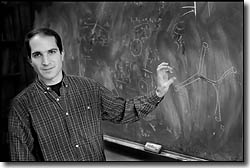A Theory About Everything — Maldacena closes in on one of universe’s deepest mysteries

The problem defied Einstein, but Harvard physicist Juan Maldacena is using black holes and tiny cosmic strings to help figure out the “Theory of Everything.”
A newly minted Harvard physics professor and recent winner of a MacArthur Foundation “genius grant,” Maldacena has devised a way to explain gravity using a theory that also explains the other three basic forces of nature.
A single theory describing natures four forces, called the “Theory of Everything,” has been the Holy Grail for physicists and other scientists seeking the universes deepest mysteries.
And in this day of high-tech gadgets growing ever smarter and more powerful, Maldacenas breakthrough came not with the help of giant particle accelerators, complex computer programs, or powerful telescopes. Instead, Maldacena relied on two ancient tools: pen and paper.
“I use computers sometimes, for e-mail or for exchanging information with colleagues,” Maldacena said, his words tinged with the Spanish accent of his native Argentina.
Maldacenas work, which focuses on black holes, has attracted a lot of attention recently. His MacArthur Fellowship spawned a spate of media stories about him and his work. He also was included in a list of 20 “young Latinos to watch” in the July 12 issue of Newsweek.
It was his doctoral dissertation four years ago that got Harvards attention. Maldacena was hired as an associate professor in January 1998, making a rapid rise to professor of physics last July.
Colleagues describe Maldacena as brilliant, but also as someone who hasnt let his newfound notoriety go to his head.
“Hes unusually modest for someone so brilliant,” said Physics Professor Andrew Strominger, who has worked with Maldacena on string theory.
Physics Professor Cumrun Vafa said Maldacenas presence in the Departments string theory group has reinforced Harvards lead in that area. Maldacenas work has made a “significant contribution” to the understanding of gravity, Vafa said.
“He is a very modest and brilliant physicist,” Vafa said.
Strominger and Vafa ought to know. Both are specialists in the branch of physics called string theory, which posits that the universe is actually made up, not of particles as is commonly understood, but of vanishingly small strings that create different particles when they vibrate at different frequencies.
It was through string theory that Maldacena found what could be the link between gravity and the other three forces: strong, weak, and electromagnetism.
The Basic Forces
Physicists believe they can explain the universe using just four basic forces. Two of the forces function at the atomic level:
- The strong force functions only at the minute distances inside a nucleus and is responsible for holding particles in the atomic nuclei together.
- The weak force also functions at the nuclear level. It is far weaker than the strong force and is responsible for radioactive decay.
Scientists believe there are two other forces:
- Electromagnetism functions both at the atomic level and on a larger scale, and is responsible for interactions between charged particles resulting in electricity and magnetism.
- Gravity is an attractive force that acts on large objects over large distances. Gravity keeps our feet on Earth rather than letting us sail away. The gravity of a massive body like the sun acts on the Earth to keep it in orbit.
Scientists started out with independent theories of how each of these four forces works. One by one, new discoveries and new thinking found links between the theories, eventually explaining three of the forces strong, weak, and electromagnetism with a theory called “quantum field theory.”
Gravity has resisted explanation by quantum field theory, but in studying black holes which are tiny like atomic particles but very, very heavy like the stars and planets ruled by gravity Maldacena has found a way to link quantum field theory with string theory, which can explain gravity.
How Things Work
Maldacena said he enjoys teaching because it is a learning experience for himself as well as for the students. He said he tries to keep in touch with his students during class by asking a lot of questions.
“Its very interesting. Its good for me because I learn something,” Maldacena said.
Maldacena came to Harvard in September 1997 as a visiting associate professor. In January 1998, Maldacena was named Thomas D. Cabot Associate Professor. He was named professor of physics last July.
Before Harvard, Maldacena studied physics at Princeton University, receiving a masters degree in 1993 and a doctorate in 1996.
His work at Princeton came on the heels of a six-year combined masters and bachelors program in Argentina, first at the University of Buenos Aires from 1985 to 1988, and then at the Instituto Balsiero at the Universidad de Cuyo in Bariloche from 1988 to 1991.
Maldacena traces his interest in physics to his childhood in Argentina. He grew up, he said, with a curiosity about how things work. His father, an engineer, was always fixing things around the house and working on the car. Maldacena would pitch in, helping his father while simultaneously indulging his own desire to understand the mechanics behind the functioning of everyday objects.
In high school, Maldacena had only limited exposure to physics, which is a relatively uncommon field of study in Argentina, he said. Still, he was drawn to the science and began studying physics in college.
That road led him here, to the admiration of colleagues in the esoteric field of string theory.
“I was interested in how things work,” Maldacena said. “You can explain how things work with physical laws and you wind up in physics.”




